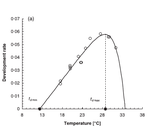Abstract
1 The objective of this study was to test the theoretical prediction that the thermal tolerance range for development in insects should be about 20 °C.
2 The data on the thermal requirements for development of 66 species from eight orders of insects was obtained from the literature. The temperatures at which the developmental rates are at their minimum and maximum was obtained for each population by defining the relationship between developmental rate (1/D) and temperature, using either Lactin et al.’s (1995) or Briére et al.’s (1999) model.
3 Thermal windows, i.e. the range in temperature between the minimum and maximum rate of development for individual species, and the relationship between the minimum and maximum temperatures, were examined.
4 The mean thermal window, 19·8 °C with 95% confidence interval 19·1–20·5 and range 13·3−28·6, was influenced by species phylogeny, with the windows narrower for species having a true pupal stage, but not by ecological traits thought to affect species thermal requirements. The relationship between the minimum and maximum temperatures was highly significant and independent of species phylogeny.
5 Theory and this analysis of empirical data indicate that each species of insect can only develop over a limited range of temperatures independent of species traits. In addition, the relationship between the minimum and maximum developmental rates co-vary independent of species phylogeny. This may help identify the precise nature of the physiological mechanism underlying the seasonal development and distribution of insects, and possibly other ectotherms.
